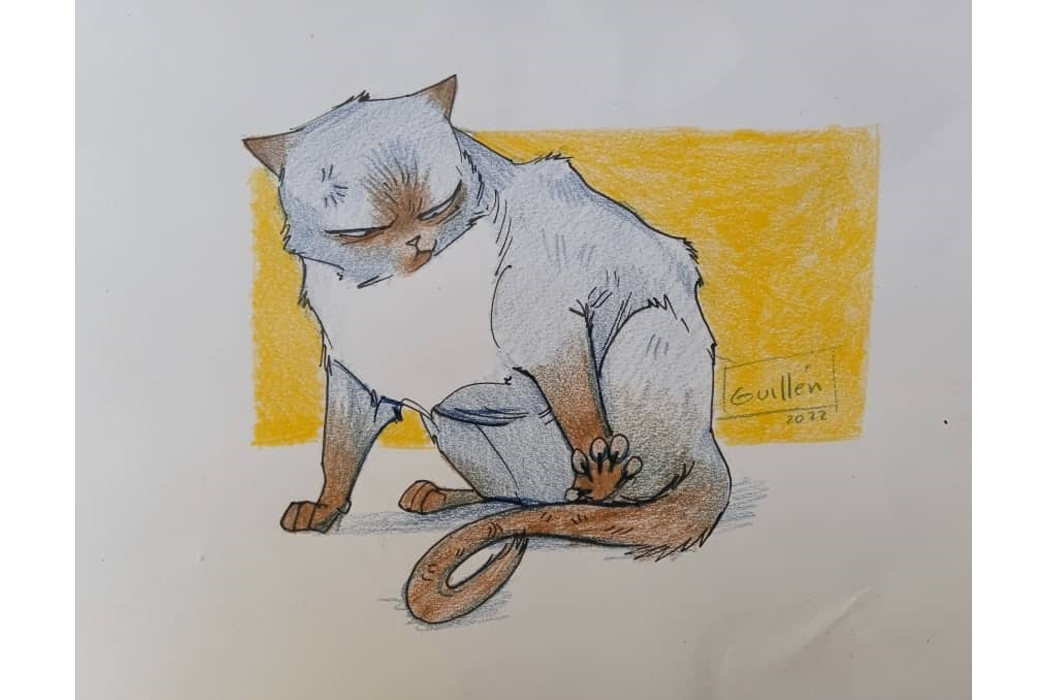I will never forget Marxo, when he came to the clinic to be castrated he was still a small kitten. All cats seem beautiful to me, but this one had too much beauty. You could shape it however you wanted, sometimes you thought you had a dog on your hands and not a cat. With the castration, Marxo highlighted his beauty very quickly, but in a short time he called me his owner and friend, worried about changes in his behavior. It was then that he began to be treated for possible Feline Hyperesthesia.
Feline hyperesthesia is still little known and there is not even an extensive bibliography.
It is a pulsatile disorder that can result in self-trauma. It has in its origin a multiple or idiopathic etiology.
This pathology has several synonyms, depending on the bibliography consulted and the author who deals with it. It can be spoken of as Apparent Neuritis, Atypical Neurodermatitis, Wavy Skin Syndrome, Nervous Cat Disease, Psychomotor Epilepsy, Siamese Pruritic Dermatitis.
Epilepsy in cats: some updates and important information for its treatment
There is a racial predisposition, since the Siamese is the one with the highest incidence of the disease. It is followed by the Burmese and then the Persian, although it can also be seen in the Abyssinian. But, beyond the breed of the animal, there is no predisposition in terms of age and sex.
It is a pathology that is still under study and has things to discover, it is for them that we talk about theories.
The first one says that it can be an atypical seizure syndrome or a focal seizure. But there is also talk of obsessive-compulsive behavior when compared to Tourette’s Syndrome in humans, in which there is talk of an exacerbated dopamine innervation. It is also said that it is a primary behavioral alteration.
Another theory refers to myopathies with vacuolar changes due to myositis caused by deposits of immune complexes in pathologies that are very compatible with humans.
The latter theory refers to irritative dermopathy due to a constant inflammatory and irritative stimulus.
Clinical signs:
- excessive vocalization
- mydriasis
- Jumping and racing episodes.
- Undulating movements on the back accompanied by undulating movements of the tail that tend to accelerate. (the most characteristic)
- tail chasing
- Self-trauma to any part of the body (Self-trauma to the tail is usually seen, but trauma to the forelimbs or hind limbs should not be ruled out).
- Sudden aggressiveness towards objects or people, even towards its owner. The cat may attack the caretaker of it. It can also be seen in these cases that when the animal’s owner touches its back, the latter responds aggressively.
- Hallucinations.
- Pendulum movements of the tail.
- Disorientation with uncontrolled urination or defecation.
This pathology is suspected when there are at least two of these clinical signs present.
Grimace Scale for cats or Feline Grimace Scale:
Pain can be one of the bases of this pathology.
Depending on its duration, it can be acute or chronic, and depending on its mechanism of action, it can be nociceptive or neuropathic. But it can also be localized or diffuse, as appropriate. According to its intensity it is classified as mild, moderate or severe.
In cats we have the Grimace Scale or Feline Grimace Scale to assess pain. This scale is based on 5 action units (AU) according to the entire face of the cat; is a tool to assess acute pain through the animal’s facial expressions.
The units are ear position, orbital opening, muzzle tension, whisker position, and head position.
Each action unit is assigned a score.
- UA Absent: Ears forward, eyes open, muzzle relaxed (round shape), whiskers relaxed and curved, head above shoulder line.
- UA Moderately present: Ears slightly apart, eyes partially open, muzzle slightly tense, whiskers slightly curved or straight, head aligned with the line of the shoulders,
- UA Markedly present: flattened and rotated ears, half-closed eyes, tense muzzle (elliptical shape), whiskers straight and forward, head below shoulder line or tilted down (chin to chest).
The final score is calculated by adding all assigned scores and dividing by the maximum possible score (10).
This scale is important to assess whether analgesics are required to treat pain. This should already be considered if the final score is greater than or equal to 0.4.
Today there is an application to use on phones and quickly calculate this, it is called Feline Grimace Scale.
Etiology of Feline Hyperesthesia:
The etiology of this disease can have a dermatological, orthopedic, behavioral or neurological origin.
In the dermatological etiology, the most classic is flea allergy dermatitis in cats allergic to flea bites. This etiology could also be due to atopic hypersensitivity and infectious dermatitis. But in this etiology it is very important to take into account food allergy.
The behavioral etiology is based on compulsive disorders, anxiety and hallucinations that may occur.
On the other hand, the orthopedic etiology is related to spinal cord compressions, tail trauma, as may be the case of a cat that injured its tail with a door, or hip osteoarthritis.
Degenerative diseases in felines are very little visible by the owners most of the time. And they have a prevalence of 90%. The characteristic clinical signs are: pain, decreased mobility and excessive licking in the affected area.
Cat guardians often cannot assess this pain because there is no claudication, it is seen more in the dog. The dog goes out for a walk more than the cat, the cat almost never and perhaps sleeps more than it should, although for the owner, who is already used to his kitten sleeping for many hours, this is normal.
There is a questionnaire for the detection of associated degenerative diseases in cats. One of the purposes of this questionnaire is to educate the guardian so that they can understand if their cat is displaying pain in any way. The other purpose is aimed at veterinarians in order to find the diagnostic route easier.
The neurological etiology thinks first of a primary and secondary epileptic seizure. The secondary could be due to intracranial pathologies or spinal cord pathologies.
In cats with epileptic crises as causes of hyperesthesia, severe biting of the flanks, extremities and tail occurs. Also possible hallucinations, undulations on the back and pendulum movements of the tail.
What diagnostic route should be taken?
First, perform a good history that offers a history or predisposing factors of anxiety or fear accompanied by a normal physical examination. In this case, a behavioral pathology should be considered.
If the physical examination is normal, it can also be completed with a dermatological examination. The latter may or may not show a dermatological pathology.
If the physical examination is not normal and clinical signs appear, such as muscle pain, increased or decreased sensation, abnormal gait, abnormal tail movements or incontinence, a neurological pathology can be suspected. If a dermatological pathology is not present and all clinical signs are present, a traumatological pathology may exist.
But if it is determined that it is not a trauma pathology, it returns to behavioral pathology.
In this algorithm, everything is related, which is why multidisciplinary work must be done.
Complementary methods to use:
Complementary methods will be used according to the suspected pathology.
Among them is the complete blood count, blood biochemistry, X-ray of joints and spine, toxoplasmosis serology, FIV and VILEF test, electromyography and nerve conduction of the sciatic-tibial nerve, study of cerebrospinal fluid and also an MRI of skull and spine from T3 to the last coccygeal vertebra.
Most of these methods are not possible under our conditions in Cuba and many times we have to limit them to our presumptive diagnosis.
In many cats it is difficult to achieve a good physical examination either of their body or of the lesions, it is for them that they have to be sedated to be able to do it.
Should drugs always be used for treatment?
To make this decision, a thorough study of the environment must first be made.
You have to observe the number of sanitary trays in the house, as well as the coexistence with other animals.
It is necessary to evaluate if the cat has high surfaces in his house where he has the possibility of developing his behavior and if his place is respected. If you have a comfortable place to sleep.
An important factor to know if the cat has a favorable environment is its independence. Cats may often seem independent, but that doesn’t mean they don’t need daily playtime and attention or petting. All cats need contact with their guardian.
In the cat, contact with the outside is very important. This does not mean that you necessarily have to go out to him, but it does mean that you at least see him from a comfortable place indefinitely, be it windows or balconies.
After making a study of the environment, it is seen whether or not it had a good evolution and it is then decided to apply drugs for different pathologies.
For the treatment of pain, gabapentin, tramadol or amitriptyline can be used, this is the most we have within our reach.
Opioids are most commonly used in cats for clinical pain management. However, despite having wide therapeutic margins, they have side effects in cats such as mydriasis, which is why owners should always be warned of these effects.
If the suspected presumptive diagnosis is neurological, then phenobarbital is used at doses of 2.5-4 mg x kg of weight every 12 hours. Diazepam can also be used in doses of 0.2mg x kg of weight every 12 hours; many times it is used, as well as a muscle relaxant, more than anything. But phenobarbital is the drug of choice, although it can cause thrombocytopenia in kittens.
Regarding behavior modulators, Lorazepam, Buspirone, Amitriptyline, Chlormipramine and Fluoxetine can be used.
To treat the behaviors it is important to do it together with an ethologist.
There are supplements such as L-Carnitine, Vitamin E that is something else that can be added to the treatment.
There are pheromone collars for cats that help a lot in this pathology, but unfortunately we do not have them in our conditions.
The indication of hypoallergenic foods in cases of food hypersensitivity is very important.
In Feline Hyperesthesia everything is related and the patient must be treated multidisciplinary because there is almost always more than one etiology present. It is important to anticipate situations that trigger it, especially when it comes to behavior and the animal should never be punished for any behavior it takes. There are no drugs or diets that respond 100%. That is why the guardian must be correctly informed about the prognosis of his animal. Clinical signs may improve, but they will never completely disappear.

















